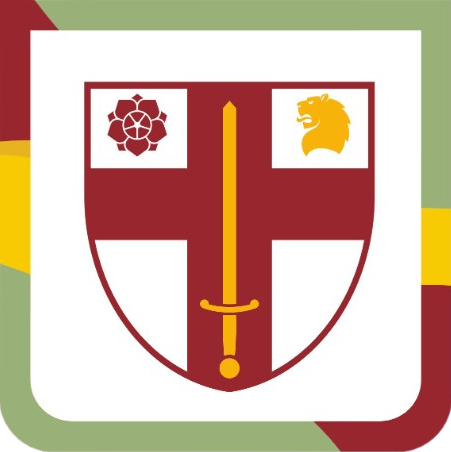Mathematics

“When He established the heavens, I was there; When He inscribed a circle on the face of the deep, I was there when he established the heavens, when he laid out the horizon on the surface of the ocean, I was there when he established the heavens, when he drew the horizon on the oceans. When he prepared the heavens, I was there: when he set a compass upon the face of the depth.”
Proverbs 8:27
Overview
KS3 Curriculum
In Key Stage 3 (KS3), pupils will be introduced to multiple new mathematical concepts and ideas, whilst also revisiting and extending upon some of the mathematics they have learnt previously. The core aims are to:
- Develop fluency with each concept
- Be able to apply mathematical reasoning to explain/justify
- Use what they have learnt to solve problems of varying difficulty.
Pupils will be challenged to think mathematically and will be expected to try their best each lesson. Everyone can do Maths!
Year 7
Sequences
Linear and non-linear sequences
Interpret/draw sequences graphically
Recognise arithmetic, geometric, and other types of sequences
Understand and use Algebraic Notation
Use functions machines numerically and algebraically
Use letters/symbols to define unknown values
Substitute into expressions
Equality and Equivalence
Understand equality, and fact families (numerically and algebraically)
Form and solve one-step equations, using inverse operations
Simplify expressions, by collecting like terms
Place Value
Recognise and use numbers up to one billion, in words, figures, and with diagrams and number lines
Compare, order and round integers and decimals
Find the range and median of sets of numbers
Investigate numbers in standard index form
Fractions, Decimals and Percentages
Represent fractions, decimals and percentages using diagrams and number lines
Convert fluently between fractions, decimals and percentages
Convert between improper fractions and mixed numbers
Applications of Addition and Subtraction
Develop mental and written methods for addition and subtraction of integers and decimals
Solve problems involving perimeter, financial mathematics, time
Construct and interpret frequency trees, bar charts and line graphs
Applications of Multiplication and Division
Develop mental and written method for multiplication and division of integers and decimals
Understand factors, multiples, highest common factor (HCF) and lowest common multiple (LCM)
Convert metric units of length, capacity and mass
Use order of operations (BIDMAS)
Solve problems involving area of rectangles, triangles, parallelograms and compound shapes
Find fraction of an amount, percentage of an amount
Find the mean of sets of numbers
Directed Numbers
Order directed numbers using diagrams and number lines
Add, subtract, multiply and divide directed numbers
Using a scientific calculator efficiently
Form and solve two-step equations, including with directed numbers
Adding and Subtracting Fractions
Add and subtract fractions and mixed numbers with a common denominator
Add and subtract fractions and mixed numbers with different denominators (by finding a common denominator)
Solve problems involving fractions and mixed numbers
Construct, Measure and use Geometric Notation
Develop labelling of vertices, sides and faces of shapes
Understand parallel and perpendicular lines, and types of triangles and quadrilaterals
Measure and draw angles using a protractor, and construct triangles
Geometric Reasoning
Use angle facts on a line, around a point, in a triangle, in a quadrilateral, and vertically opposite
Solve problems involving angles in triangles and quadrilaterals
Sets and Probability
Identify and represent sets
Draw and interpret Venn diagrams
Understand and use the rules of probability
Prime Numbers and Proof
Recognise prime numbers, square numbers and triangular numbers
Write a number as a product of its prime factors
Create and test/disprove mathematical conjectures
Developing Number Sense
Develop mental strategies to simplify problems
Use estimation
Use known numbers and algebraic facts to derive other facts
Year 8
Sequences
Generate sequences from a position-to-term rule
Find the nth term of a linear (arithmetic) sequence
Find the nth term for other sequences and patterns
Expand and Factorise Expressions
Multiply to expand single brackets
Expand two sets of single brackets, and simplify the expression by collecting like terms
Expand double brackets
Factorise expressions by taking out the highest common factor
Ratio
Express, simplify and compare ratios
Express ratios in the form 1:n and/or n:1, and solve problems
Divide a quantity into a ratio, and solve more complex problems
Recognise and use pi (π) as the ratio between the circumference and diameter of a circle
Equations and Inequalities
Form and solve two-step equations, and three-step equations involving brackets
Form and solve equations involving unknowns on both sides
Represent inequalities on number lines, and form inequalities from number lines
Solve linear inequalities and find sets of integers which satisfy an inequality
Indices
Evaluate expressions involving squares, cubes and roots (mentally and using a scientific calculator)
Add, subtract, multiply and divide numbers in index form
Use the laws of indices to multiply and divide numbers written in index form
Multiplicative Change
Solve problems involving direct proportion, including recipes
Explore similar shapes, and scale factors / scale drawings
Draw and interpret scale drawings, and interpret maps using scale and ratios
Multiplying and Dividing Fractions
Multiply and divide an integer by a fraction
Multiply and divide fractions
Multiply and divide mixed numbers
Percentages
Calculate percentages of amounts (mentally and using a scientific calculator)
Calculate percentage increase and decrease (mentally and using a scientific calculator)
Calculate percentage change (mentally and using a scientific calculator)
Standard Index Form
Write a number in standard index form (positive and negative indices)
Convert a number from standard index form back into an ‘ordinary’ number (positive and negative indices)
Add and subtract numbers in standard form (mentally and using a scientific calculator)
Number Sense
Round numbers to a given number of decimal places / significant figures
Use estimation
Use inequality notation to show an error interval for a rounded number
Working in the Cartesian Plane
Plot and read coordinates in all four quadrants, and solve problems to find missing coordinates
Recognise and draw equations of horizontal and vertical lines, including the x and y axes
Recognise and draw equations of y=x and y=-x
Plot graphs of functions in the form y=mx+c
Find/interpret the gradient of a line, and find/interpret the y-intercept of a line
Find the midpoint of two points, graphically and algebraically
Representing Data
Draw and interpret scatter graphs of bivariate data
Identify outliers, draw a line of best fit, and make predictions
Understand types of correlation
Draw and complete two-way tables
List outcomes for single and combined events systematically
Tables and Probability
Construct sample space diagrams for more than one event
Find probabilities from a sample space diagram
Angles
Revisit angle rules and use in complex diagrams
Find angles in parallel lines, using alternate, corresponding and co-interior angle rules
Area
Find area of composite shapes
Solve problems involving area, including money, fractions and algebra
Plans and Elevations
Visualise and draw plan view, front and side elevations of a 3D shape
Sketch a 3D shape from its plan view, front and side elevations
The Data Handling Cycle
Interpret statistical diagrams, including vertical line graphs, time series, pie charts & bar charts (dual and composite)
Construct and interpret pie charts
Measures of Location
Revisit mean, median, mode & range
Solve problems involving the reverse mean
Constructions
Use a ruler and pair of compasses to construct the bisector of a given angle
Use a ruler and pair of compasses to construct angles of 90o and 45o
Year 9
Straight Line Graphs
Plot and interpret graphs in the form y=mx+c
Find the equation of a straight line from a graph, from the gradient & y-intercept, and from two coordinates
Find solutions to linear simultaneous equations graphically
Ratio and Proportion
Direction and inverse proportion problems and graphs, including drawing and interpreting conversion graphs
Currency conversions, working with recipes and scale
Divide a quantity into a ratio, and solve more complex problems – extending from Year 8
Solve problems by combining ratios
Area
Revisit area of rectangles, parallelograms, triangles, and compound shapes
Find the area of a trapezium, and solve problems
Find the area of a circle, and solve problems
3D Shapes
3D shapes, including finding the number of faces, edges and vertices, and drawing nets
Find the surface area of prisms, including cubes, cuboids, triangular prisms, cylinders.
Draw and interpret plans and elevations of 3D shapes, and sketch a shape from its plan and elevations
Algebraic Thinking
Form and solve equations in a variety of contexts
Change the subject of formulae
Expand double and triple brackets
Factorise and solve simple quadratic equations
Volume
Find the volume of prisms, including cubes, cuboids, triangular prisms, cylinders
Compound Measures
Solve problems involving speed, distance, time
Solve problems involving density, mass, volume
Solve problems involving pressure, force, area
Standard Index Form
Revisit writing numbers in standard form, and converting back into regular form
Multiply and divide numbers in standard form
Percentages
Revisit percentage change with and without a calculator, including simple interest
Solve problems involving compound interest and depreciation
Reverse percentage problems
Repeated percentage change problems
YEAR 9 MONEY WEEK
Work with contexts around bills, wages, tax, interest, bank statements
Value for money
Angle Rules
Revisit angle rules on a straight line, in a triangle, around a point, in a quadrilateral
Revisit angle rules on parallel lines
Introduce bearings – drawing, measuring, reading, calculating
Solve algebraic problems involving angles
Congruency and Enlargement
Understand congruency and similarity – differences between them
Enlarge shapes by a positive integer scale factor, and by a positive fractional scale factor
Describe enlargements fully
Pythagoras’ Theorem
Introduction to Pythagoras’ Theorem with right-angled triangles – language of hypotenuse
Use Pythagoras’ Theorem to find missing lengths in right-angled triangles
Use Pythagoras’ Theorem to solve problems
Investigate trigonometric ratios (introduction to trigonometry) in right-angled triangles
Transformations
Identify and draw lines of symmetry; Identify the order of rotational symmetry of shapes
Drawing and describing reflections
Drawing and describing translations, including introducing column vectors
Drawing and describing rotations
Combining multiple transformations
Statistics
Find mode and range from lists and frequency tables, for both discrete and continuous data
Calculate the mean from lists and frequency tables, for both discrete and continuous data
Graphs
Recognise, sketch & produce graphs of quadratic functions
Recognise reciprocal and reciprocal graphs
Testing Conjectures
Investigate mathematical conjectures, including true/false problems, always/sometimes/never problems
Constructions
Construct, using pairs of compasses, an angle bisector
Construct, using pairs of compasses, a perpendicular bisector of a line


